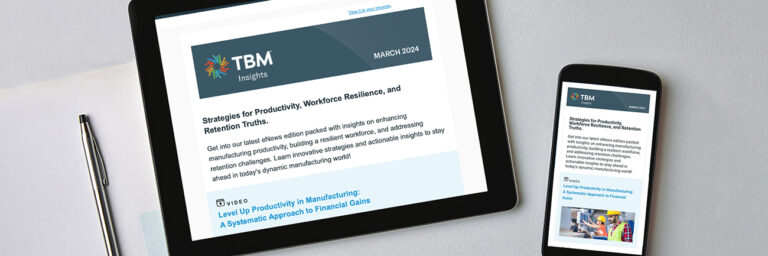Recession won’t fix your talent problems. Smart strategy will.
For a long time, manufacturers have been struggling with not enough people to meet demand. Now the high-inflation, high-cost economy is driving down demand and raising employment costs at the same time. Will the script flip, force companies into another round of mass layoffs?
This might be the knee-jerk reaction. But it’s not advisable. Manufacturers who cut their staffs at the onset of the pandemic have been struggling to rebuild ever since. You can’t afford two major workforce reductions in as many years and expect to retain any degree of trust or loyalty among the talent pool you need today and when growth returns. Employees will worry they are on the chopping block and will look for more stable opportunities. Such a move could damage business reputation for a long time coming.
The wiser approach is to focus on right sizing and optimizing the workforce to more closely link your talent reality to your business strategy. This could involve making some tough choices and tradeoffs between what you produce and how you produce it. But if the economic downturn affords you the space to get out of fire-fighting mode and build a better strategy for sound, sustainable operations where all employees contribute to their fullest potential, then you need to lean into that opportunity right now.
Here’s how to get it done.
- Embrace your talent reality. If you’re like most manufacturers, you are still dealing with the ongoing labor pinch and many unfilled positions. Any potential recession is expected to be mild and will likely not lead to a flood of applicants for available jobs. In other words, you can’t expect to suddenly have access to the skilled talent you’ve been struggling to find for so long. The massive labor mismatch – between the skills companies need and the skills available on the market—will persist.
This is the time to closely evaluate the situation and gain a keener understanding of what is happening at every level within the business. Beyond the leadership level, labor is often underappreciated and ignored as part of business strategy. But if the root cause of consistently missed production goals comes down to talent—the skills you need either don’t exist or are too expensive to train or retain—you must come up with a plan B.
Options might include changing a process, introducing automation, or creating a robust internal training program and cross-training the workforce. Or it may mean moving away from the product all together. Tradeoffs and costs will have to be carefully considered. But now is the time to start assessing your greatest labor risks and make strategic business decisions around how to address them.
- Augment with automation. Robotics, automation, and technology do not have to be talent reduction strategies. They can be ways to support and optimize your current and existing workforce for greater efficiency and productivity. When you look at it through this lens, the results not only boost profitable output, but they can also help with employee satisfaction and retention, too.
When evaluating how you may be able to change the labor structure with automation, start by looking at the areas where you have the biggest labor shortages, the most turnover, and the highest training costs. This is where you need to determine how to do more with fewer people and how to be productive with the smallest possible team, especially as you are now likely paying more for each individual you employ.
We worked with one organization failing to attract and retain enough welders, even when the company increased wages significantly. TBM suggested introducing robotics. The cost of the technology investment was steep, but it was less than the costs associated with continuously training and retraining people combined with the missed revenue opportunity due to a lack of ability to complete the work. Ultimately, the solution enabled the company to meet its production goals with a right-sized team. It improved the work for the welders who were onboard, creating a powerful retention advantage.
- Be surgical and purposeful about making cuts. To reiterate, the last thing any manufacturer should do right now is hit the panic button and starting exiting people across the board. At a time when everything costs more, it is critical to ensure you are extracting the greatest value from each resource. Some companies are taking advantage of the economic downturn to prune the workforce. Such an approach works best when organizations can keep politics and emotion out of the equation and structure decision making in a way that keeps employees’ needs in mind.
Start by evaluating the team on an individual basis and considering how to strategically balance performance, tenure, and compensation. Often companies find they have high paid employees who have been with the company a long time and are in senior positions—but their output and effort do not necessarily match with the compensation they are earning. Could a move be made that would benefit both the organization and its employees by ensuring everyone is on the “right seat on the bus”?
We worked with one company where a high paid leader simply was not up for the demands of the job anymore. Given the opportunity to move into a different role with reduced hours and responsibility, that leader gladly accepted the change including the lower salary that came with it. This opened the door to move another team member with new energy and perspective into the leadership role at a lower cost. It ensured the organization didn’t lose the opportunity to transfer valuable knowledge from the incumbent to the newly emerging leader while giving both members of the team the right opportunity to contribute at the right level.
Ideally, this type of exercise and evaluation should be done an annual basis. It prevents organizations from becoming complacent and leaving people in roles longer than they should be, which can be a disadvantage to both the company and its employees. Thoughtful consideration can help organizations determine if there are people who are ready to move up, or to potentially move on to another phase in their careers or even another organization. It helps justify labor costs by ensuring the right people are in the right positions and delivering the value the company needs and expects from each role.
Lean into the opportunity to rebuild your approach to labor.
Talent costs more right now. And the right skills are still extremely difficult to find. That forces your talent strategy to optimize the effectiveness and contribution of every member of your team. Start by understanding where your gaps lie. Then determine how you can change processes, add technology, or readjust the org chart to close those gaps in the quickest, most cost-effective ways. These steps will help you right size not only for the current economic climate, but to ensure the greatest degree of labor productivity and value in any environment we may face in the future.






